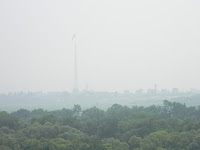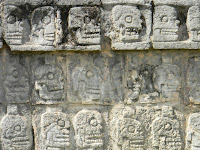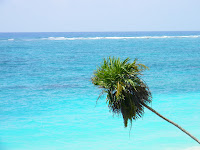A visit to the Korean Demilitarized Zone (aka "DMZ") is considered a once in a lifetime opportunity for most foreign visitors to Korea. Today was my second time to go...so I better not push my luck too much, huh?
We left our hotel a little before 10:00 and then proceeded to the Lotte Hotel/Shopping complex to pick up our guide for the day. We had a few minutes to browse through Lotte's duty free shops. My excuse for not buying a pair of uber sexy Louis Vitton shoes is that 9-1/2 was the largest they had and I needed 10-1/2; this decision was NOT due of the $960 price tag on them <grin>.
 |
| Kelly helping heal the no-shoe pain |
We then drove the hour or so from Seoul to the outskirts of the DMZ for what would be our final meal together as a full group: a wonderful beef bulgogi lunch cooked in a pot on our tables.
 |
| Lyn and Jess |
 |
| Amber and David |
Next we made our way to Imjingak. This area was developed in hopes that it would provide a location where families from each the North and the South could visit each other, hopes that have never proved true in that the North will not allow it. This location was selected because it is the southern edge of the "Bridge of Freedom". It was on this bridge where prisoners of war were exchanged between the two Koreas following their armistice.
Leaving Imjingak, we made our way to Camp Bonifas which is located just south of the actual southern boundary of the DMZ. We were given a short introduction to the DMZ and Joint Security Area (JSA) and then boarded an official DMZ bus to continue on to Panmunjom. Crossing into the DMZ and driving toward Panmunjom, we could see the flags flying at each
Daeseong-dong (aka "Freedom Village") in the South and
Kijong-dong (aka "Propaganda Village") in the North.
 |
| Kijong-dong village |
Our bus finally stopped just outside of Freedom House. We were escorted inside and lined up on the stairway in two-single file lines. Then we began moving outside again through the tented glass doors held open by guards and walked directly into the small blue building which straddles "the line". It is in this building's single meeting room where all of the historic and high level diplomatic meetings between North and South occur. The main table is placed directly over "the line" which is indicated by the layout of microphones on the table which provide 24-hour a day monitoring of what is said in the room. With only two South Korean guards and our U.S. Army escort in the building, we were able to move freely about the room including the crossing of "the line".





This portion of the Panmunjom visit which I made in 2009 did not occur. So while I have returned to South Korea and Panmunjom, this is my first time to enter North Korea. It's quite an emotional moment to be there. You know it's the "other side", the "bad side", and yet there you are without harm coming to you.
Leaving the building on "the line" we went back to the porch of Freedom House and had an opportunity to take pictures of Panmon Hall on the opposite side of "the line" from Freedom House. It's kind of chilling looking through your camera's zoomed-in lens to see a North Korea guard staring back at you through his binoculars. While the whole experience is tense due to the physical plot of land on which you are standing and knowing the history of the JSA and DMZ, it is also comforting to know that while we were in this place diplomatic conversations between North and South were occurring nearby to help resolve some of the recent tensions which resulted in the closing of the
Kaesong Industrial Complex (located in the North and yet administered by the South--Northern employees and Southern employers).
In closing, all I can say is "wow" to this day of roaming the roads of lands remote!







































































